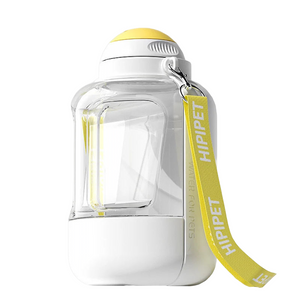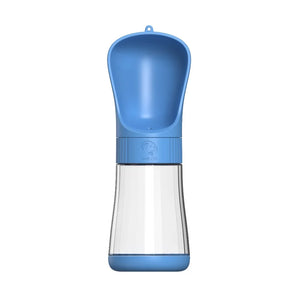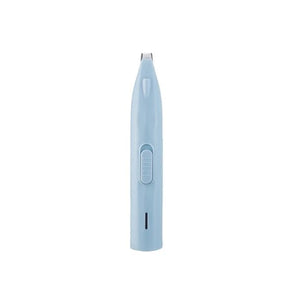
Comprehensive Summer Care for Dogs: A Detailed Guide
Share
Introduction
Summer is a fun time for dogs, but it can also present several challenges due to high temperatures, humidity, and potential health risks. Dogs are susceptible to heat-related illnesses like heatstroke and dehydration, particularly breeds with thick coats or those prone to respiratory issues. Ensuring your dog stays cool, hydrated, and healthy during the summer requires a proactive approach. This guide will cover all aspects of summer care for dogs, including environmental adjustments, diet, prevention of heat-related illnesses, grooming, and more. With proper care, your dog can enjoy the summer months safely.
1. Understanding Dogs' Physiological Reactions to Heat
1.1 How Do Dogs Handle Heat?
Dogs don’t sweat like humans. Instead, they rely primarily on panting and minimal sweating through their paw pads to release heat. This mechanism, while effective in mild weather, can be insufficient in extreme temperatures, making dogs vulnerable to overheating.
- Panting: Dogs pant to cool themselves by evaporating moisture from their tongues and respiratory systems. However, in high humidity or extreme heat, panting alone may not be enough to lower their body temperature.
- Seeking Shade: Dogs naturally seek shaded areas to escape the heat. However, prolonged exposure to high temperatures, even in shaded spots, can lead to heat exhaustion.
- Paw Pads and Sweating: Dogs sweat through their paw pads, but this has a minimal cooling effect and can’t counteract extreme heat.
1.2 Recognizing Signs of Heat Stress and Health Risks
Heat-related illnesses in dogs can escalate quickly, so it’s essential to recognize early signs of distress:
- Excessive Panting: Heavy, rapid panting is an early indicator of overheating.
- Lethargy: A noticeable decrease in activity or unwillingness to move may signal heat exhaustion.
- Drooling and Red Gums: Excessive drooling, red or pale gums, and vomiting are signs that your dog may be suffering from heatstroke.
- Rapid Heart Rate: If your dog’s heart rate becomes elevated and they appear disoriented, immediate action is needed to prevent heatstroke.
Breeds like Bulldogs, Pugs, and other brachycephalic (short-nosed) breeds are particularly at risk of heatstroke due to their limited respiratory capacity.
2. Keeping Your Dog's Environment Cool in Summer
2.1 Maintaining a Comfortable Indoor Climate
Keeping your dog cool at home is one of the easiest ways to prevent heat stress during summer.
- Air Conditioning and Fans: Air conditioning is the best way to keep the indoor environment cool for your dog. Fans can also help circulate air, but ensure your dog has access to a consistently cool space.
- Cooling Mats and Elevated Beds: Cooling mats designed for dogs help dissipate heat from their bodies, providing relief during hot days. Elevated beds also allow for better airflow beneath your dog, keeping them cooler.
- Limiting Direct Sunlight: Close blinds or curtains during the hottest parts of the day to block out direct sunlight and keep the temperature down.
Recommended Products:
- Cooling Dog Mats
- Water Dog Beds for Hot Weather
2.2 Adjusting Outdoor Activities
Outdoor activities should be carefully scheduled during the summer to avoid the hottest parts of the day.
- Walk During Cooler Hours: Walk your dog early in the morning or late in the evening when temperatures are cooler. Midday heat can be dangerous for dogs, especially on pavement that can become extremely hot.
- Provide Shady Areas: If your dog spends time outdoors, ensure they have access to shaded areas and fresh water. Setting up a canopy or tent can help provide extra shade in your yard.
- Avoid Hot Pavement: Pavement and asphalt can become hot enough to burn your dog’s paws. Test the surface with your hand—if it’s too hot for you, it’s too hot for your dog. Consider using protective booties to shield their paws from hot surfaces.
3. Summer Hydration and Dietary Adjustments
3.1 Ensuring Proper Hydration
Adequate hydration is critical in summer as dogs lose moisture through panting and minimal sweating.
- Constant Access to Fresh Water: Ensure your dog always has access to fresh, clean water, both indoors and outdoors. Carry portable water bowls when going on walks or hikes to keep your dog hydrated.
- Electrolyte Supplements: For highly active dogs or those exposed to high heat, adding electrolytes to their water can help maintain hydration levels and prevent heat exhaustion.
- Recognizing Dehydration: Watch for signs of dehydration, such as dry gums, sunken eyes, and excessive panting. If you notice any of these symptoms, cool your dog down and encourage them to drink water.
Recommended Products:
- Portable Dog Water Bottles
- Dog-Friendly Electrolyte Solutions
3.2 Summer Diet Adjustments
Dietary changes can help keep your dog comfortable during the summer months.
- Lighten Meals: Dogs may have a reduced appetite during the summer due to lower energy needs, so consider adjusting portion sizes. Lighter meals can help prevent overeating and excessive weight gain.
- Incorporate Wet Food: Wet food contains more moisture than dry kibble, helping to keep your dog hydrated. You can also make frozen treats using dog-friendly broth or water with fruits like watermelon (in moderation).
4. Grooming and Coat Management for Hot Weather
4.1 Grooming Tips for Summer
Proper grooming is crucial in summer, especially for dogs with thick or long coats, as it helps regulate their body temperature and prevents overheating.
- Regular Brushing: Brushing your dog frequently helps remove loose fur and undercoat, which can trap heat close to the body. For double-coated breeds, it’s essential to remove excess undercoat during shedding periods.
- Avoid Shaving: Many owners are tempted to shave their dog’s fur during summer, but a dog’s coat actually serves as insulation, protecting them from both heat and sunburn. Instead of shaving, opt for trimming if necessary and regular grooming to maintain airflow through their fur.
Recommended Products:
- Deshedding Tools for Double-Coated Breeds
- Grooming Brushes for Summer Coat Care
4.2 Protecting Skin and Paws
Hot weather can affect your dog’s skin and paws, especially if they spend time walking on hot pavement or lounging in the sun.
- Paw Protection: Pavement and sand can become extremely hot and cause burns to your dog’s paws. Using paw balm can help protect against burns, or you can invest in protective dog booties for outdoor walks.
- Sun Protection: Light-colored or hairless dogs are at higher risk of sunburn. Apply pet-safe sunscreen to vulnerable areas like the nose, ears, and belly before spending extended time outdoors.
Recommended Products:
- Dog Paw Balm for Heat Protection
- Pet-Friendly Sunscreen for Dogs
5. Preventing Heatstroke and Overheating
5.1 Recognizing and Responding to Heatstroke
Heatstroke is a life-threatening condition that occurs when a dog’s body temperature rises too high. Knowing the signs of heatstroke and how to respond can save your dog’s life.
- Symptoms of Heatstroke: Signs include heavy panting, drooling, vomiting, lethargy, bright red or pale gums, and collapse. Immediate action is required if you notice these symptoms.
- Immediate Action: Move your dog to a cool, shaded area, offer small amounts of water, and apply cool (not cold) water to their body, focusing on the paws, belly, and head. Always seek veterinary care immediately, as heatstroke can cause organ damage.
5.2 Preventing Overheating
Taking proactive steps can prevent overheating and help your dog stay cool during hot weather.
- Limit Outdoor Time: Avoid prolonged outdoor activities during peak heat hours. Ensure your dog takes breaks indoors or in a shaded area to cool down between play sessions.
- Cooling Gear: Invest in cooling vests, bandanas, or collars that help regulate your dog’s body temperature by absorbing and evaporating heat.
Recommended Products:
- Cooling Vests and Bandanas for Dogs
- Dog Cooling Collars
6. Managing Parasites and Other Summer Health Risks
6.1 Flea, Tick, and Mosquito Prevention
Parasites thrive during the summer months, increasing the risk of flea infestations, tick bites, and mosquito-borne diseases like heartworm.
- Flea and Tick Preventives: Apply topical or oral flea and tick treatments regularly to protect your dog from infestations. Flea collars and spot-on treatments can provide extended protection throughout the summer.
- Heartworm Prevention: Mosquitoes transmit heartworm, a dangerous disease that can be fatal if untreated. Ensure your dog is on a heartworm prevention program, as recommended by your vet.
Recommended Products:
- Flea and Tick Preventive Treatments
- Heartworm Preventive Medication
6.2 Summer Environmental Hazards
In addition to parasites, the summer environment poses several other risks for dogs.
- Water Safety: Many dogs enjoy swimming, but not all dogs are natural swimmers. Always supervise your dog around water, and consider using a dog life jacket for extra safety during boating or swimming trips.
- Toxic Plants: Summer gardens and outdoor spaces may contain plants that are toxic to dogs, such as lilies, azaleas, and certain ferns. Be aware of your surroundings and prevent your dog from ingesting harmful plants.
- Never Leave Dogs in Hot Cars: Even a few minutes in a hot car can be deadly for dogs. Always take your dog with you or leave them at home if you’ll need to leave the car for any amount of time.
7. Managing Summer Behavioral Changes
7.1 Coping with Summer Lethargy
Dogs often become less active in the heat, conserving energy to avoid overheating. This lethargy is normal, but you should still ensure they get enough mental stimulation.
- Gentle Indoor Play: Encourage light indoor activities during the hottest parts of the day. Puzzle toys and interactive games can keep your dog engaged without physical exertion.
- Monitor for Abnormal Behavior: If your dog seems unusually lethargic or shows other signs of distress, such as a lack of appetite or reluctance to drink water, consult your vet to rule out health issues.
7.2 Managing Anxiety During Summer Events
Summer often brings fireworks, thunderstorms, and other loud events that may cause anxiety in dogs.
- Create a Calm Space: Set up a safe, quiet area for your dog to retreat to during stressful events. Use calming products like anxiety wraps, pheromone diffusers, or calming treats to help soothe their nerves.
- Consult a Veterinarian: For severe anxiety, your vet may recommend calming supplements or medication to help your dog cope with fireworks, thunderstorms, or travel-related anxiety.
Recommended Products:
- Anxiety Wraps for Dogs
- Calming Dog Supplements
8. Transitioning from Summer to Cooler Weather
As summer transitions into autumn, you can start adjusting your dog’s routine and environment to prepare for the upcoming cooler months.
8.1 Adjusting Outdoor Activities
As temperatures cool, you can gradually increase your dog’s outdoor time and activity level. However, continue monitoring for early signs of overheating, especially in warmer climates.
8.2 Preparing for Fall Grooming
As your dog’s coat begins to grow thicker in preparation for winter, continue regular grooming sessions to manage shedding and prevent matting. Proper grooming will ensure that their winter coat remains healthy and functional.
Tips:For heat-relief ointments or other functional medications, please consult a veterinary hospital rather than purchasing them directly from a website. Just as people are different, so are dogs, and they need a doctor’s advice or prescription. This will help prevent any harm to your pet companions.
Conclusion
Proper summer care for dogs involves staying vigilant about their environment, hydration, grooming, and health. By making small adjustments, such as scheduling walks during cooler hours, providing constant access to water, and using cooling products, you can help prevent heat-related illnesses. With the right approach, your dog can enjoy the summer months comfortably and safely.

References
- Smith, J. (2020). "Canine Thermoregulation and Heat Management in Hot Weather." Journal of Veterinary Health, 18(2), 125-138.
- Johnson, A. (2019). "Preventing Heatstroke in Dogs: Tips for Summer Safety." Pet Care Review, 8(3), 98-110.
- Davis, L. (2021). "Grooming and Coat Care for Dogs During the Summer Months." Canine Grooming Science, 10(4), 201-220.
- Walker, M. (2020). "Hydration and Diet Adjustments for Dogs in Hot Weather." Veterinary Nutrition Review, 6(2), 150-167.
Related articles:














